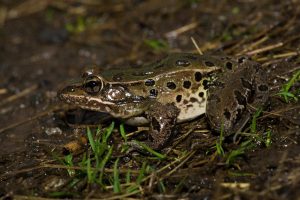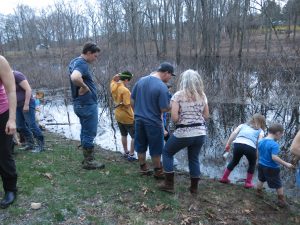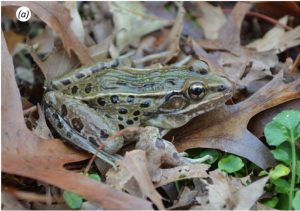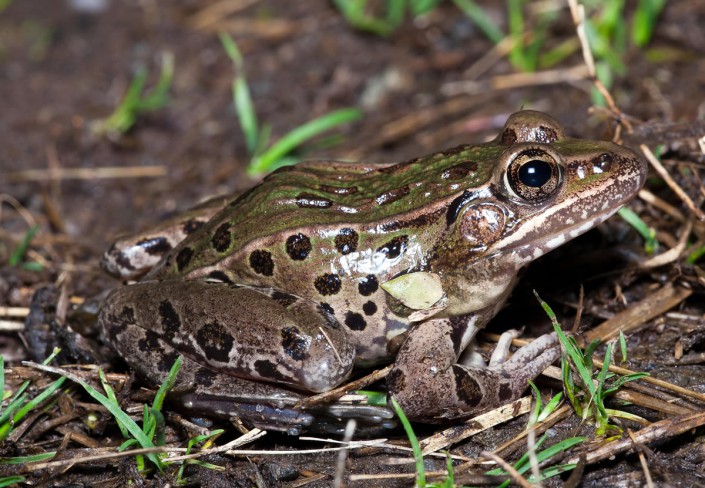New Year brings a new amphibian!
by Allegra Mitchell, Wildlife Biologist
Each New Year promises an exciting year ahead, and conservation science is no exception! As biologists gear up for the field season, CWF’s amphibian programs are particularly noteworthy.
Our Amphibian Crossing Project has made major strides in protecting the frogs, toads, and salamanders migrating to breeding areas, and we’re launching a new program this year to better document the newly discovered mid-Atlantic coast leopard frog. You can help CWF biologists collect data and save these fragile creatures.
Read below for more details about each program. In the meantime, if you would like to support CWF’s amphibian programs, please visit our YouCaring page here: https://www.youcaring.com/conservewildlifefoundationofnewjersey-1091698 . Your contribution will help us develop training materials and cover research expenses to protect our most vulnerable frogs and salamanders!
Amphibian Crossing: A New Twist on an Old Program

The long-standing Amphibian Crossing Project, established in partnership with the New Jersey Endangered and Nongame Species Program (ENSP) in 2002, has been organizing dedicated volunteers each spring to chauffer migrating amphibians across roads as they trek from their upland hibernation sites to their breeding ponds. This program has saved thousands of frogs, toads, and salamanders from vehicle strikes so that local amphibian population sizes can be maintained, which is especially important for species of concern, such as the Jefferson and spotted salamanders.
Seeking a more long-term solution to the amphibian road mortality problem at the Amphibian Crossing Project’s top site, ENSP has finally secured funding to construct crossing structure system for amphibians to move safely across Waterloo Road in Byram Township, Sussex County. This system, including under-road tunnels and guide fencing, will help amphibians avoid problems on the road all season long. CWF is preparing its second year of monitoring along Waterloo Road to track the changes in amphibian vehicle-caused mortality before and after this system is installed.
Leopard Frogs: A New Program for a New Species

This year marks the launch of CWF’s Kauffeld’s Calling Frogs program. Similar to New Jersey’s Calling Amphibian Monitoring Program (CAMP), volunteers will listen and document frog calls during the breeding season. Kauffeld’s Calling Frogs, however, will focus specifically on the newly discovered mid-Atlantic coast leopard frog. This frog, named after the late avid herpetologist Carl Kauffeld, had been mistaken as a member of the southern leopard frog species for decades. Only recently was it determined to be a separate species with unique habitat requirements.
Despite only being an official species since 2014, it is already considered a Species of Greatest Conservation Need in New York, and may be declining from other portions of its range. CWF biologists are eager to document the current extent of this frog’s range within New Jersey in order to monitor the population for possible declines. Knowing where this species is found is the foundation for future research into its habitat needs and threats.
Getting the Public Involved
 These amphibian programs cannot move forward without the dedication of CWF volunteers. Over 100 volunteers have been involved with the Amphibian Crossing Project, and a dozen more dedicated at least a day a week for months to monitor Waterloo Road amphibian mortality. With the success of CAMP in mind, this first year of Kauffeld’s Calling Frogs promises to be full of new frog population discoveries.
These amphibian programs cannot move forward without the dedication of CWF volunteers. Over 100 volunteers have been involved with the Amphibian Crossing Project, and a dozen more dedicated at least a day a week for months to monitor Waterloo Road amphibian mortality. With the success of CAMP in mind, this first year of Kauffeld’s Calling Frogs promises to be full of new frog population discoveries.
Make sure to follow CWF on Facebook, Twitter, and Instagram for the latest updates on our amphibian programs as the season progresses!
And consider supporting our YouCaring amphibian campaign here: https://www.youcaring.com/conservewildlifefoundationofnewjersey-1091698 .

